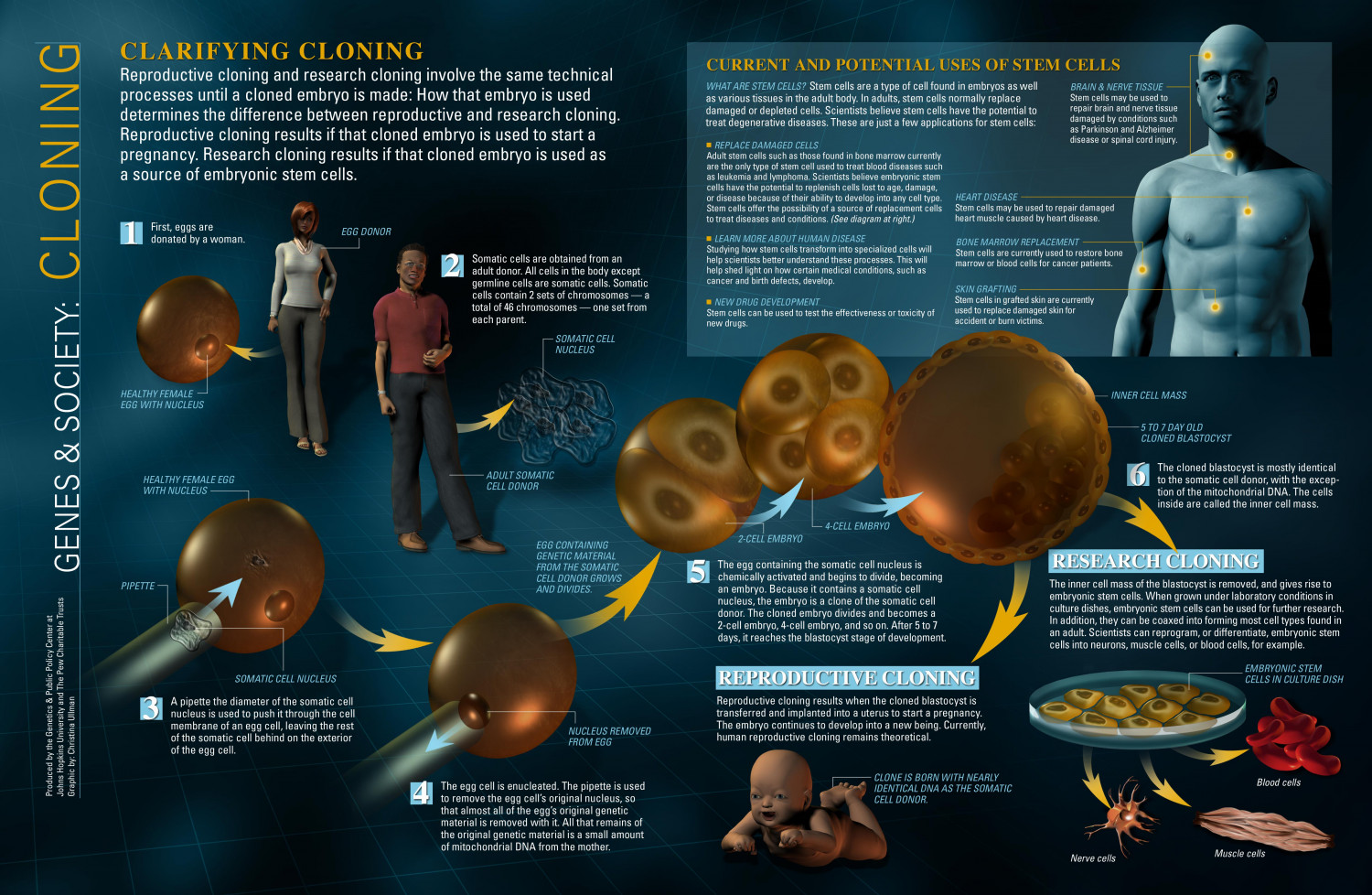
Genes & Society: Cloning
CLARIFYING CLONING CURRENT AND POTENTIAL USES OF STEM CELLS Reproductive cloning and research cloning involve the same technical processes until a cloned embryo is made: How that embryo is used determines the difference between reproductive and research cloning. Reproductive cloning results if that cloned embryo is used to start a pregnancy. Research cloning results if that cloned embryo is used as a source of embryonic stem cells. WHAT ARE STEM CELLS? Stem cells are a type of cell found in embryos as well as various tissues in the adult body. In adults, stem cells normally replace damaged or depleted cells. Scientists believe stem cells have the potential to treat degenerative diseases. These are just a few applications for stem cells: BRAIN & NERVE TISSUE Stem cells may be used to repair brain and nerve tissue damaged by conditions such as Parkinson and Alzheimer disease or spinal cord injury. REPLACE DAMAGED CELLS Adult stem cells such as those found in bone marrow currently are the only type of stem cell used to treat blood diseases such as leukemia and lymphoma. Scientists believe embryonic stem cells have the potential to replenish cells lost to age, damage, or disease because of their ability to develop into any cell type. Stem cells offer the possibility of a source of replacement cells to treat diseases and conditions. (See diagram at right.) HEART DISEASE Stem cells may be used to repair damaged heart muscle caused by heart disease. 11 First, eggs are donated by a woman. EGG DONOR I LEARN MORE ABOUT HUMAN DISEASE Studying how stem cells transform into specialized cells will help scientists better understand these processes. This will help shed light on how certain medical conditions, such as cancer and birth defects, develop. BONE MARROW REPLACEMENT Stem cells are currently used to restore bone marrow or blood cells for cancer patients. Somatic cells are obtained from an adult donor. All cells in the body except germline cells are somatic cells. Somatic cells contain 2 sets of chromosomes total of 46 chromosomes – one set from each parent. SKIN GRAFTING Stem cells in grafted skin are currently used to replace damaged skin for accident or burn victims. NEW DRUG DEVELOPMENT Stem cells can be used to test the effectiveness or toxicity of new drugs. SOMATIC CELL NUCLEUS HEALTHY FEMALE INNER CELL MASS EGG WITH NUCLEUS -5 TO 7 DAY OLD CLONED BLASTOCYST The cloned blastocyst is mostly identical to the somatic cell donor, with the excep- tion of the mitochondrial DNA. The cells inside are called the inner cell mass. ADULT SOMATIC HEALTHY FEMALE EGG CELL DONOR WITH NUCLEUS 4-CELL EMBRYO 2-CELL EMBRYO EGG CONTAINING GENETIC MATERIAL RESEARCH CLONING 51 The egg containing the somatic cell nucleus is chemically activated and begins to divide, becoming an embryo. Because it contains a somatic cell nucleus, the embryo is a clone of the somatic cell donor. The cloned embryo divides and becomes a 2-cell embryo, 4-cell embryo, and so on. After 5 to 7 days, it reaches the blastocyst stage of development. FROM THE SOMATIC CELL DONOR GROWS The inner cell mass of the blastocyst is removed, and gives rise to embryonic stem cells. When grown under laboratory conditions in culture dishes, embryonic stem cells can be used for further research. In addition, they can be coaxed into forming most cell types found in an adult. Scientists can reprogram, or differentiate, embryonic stem cells into neurons, muscle cells, or blood cells, for example. PIPETTE AND DIVIDES. EMBRYONIC STEM SOMATIC CELL NUCLEUS REPRODUCTIVE CLONING CELLS IN CULTURE DISH 31 A pipette the diameter of the somatic cell nucleus is used to push it through the cell membrane of an egg cell, leaving the rest of the somatic cell behind on the exterior Reproductive cloning results when the cloned blastocyst is transferred and implanted into a uterus to start a pregnancy. The embryo continues to develop into a new being. Currently, human reproductive cloning remains theoretical. NUCLEUS REMOVED FROM EGG of the egg cell. CLONE IS BORN WITH NEARLY IDENTICAL DNA AS THE SOMATIC Blood cells 41 The egg cell is enucleated. The pipette is used to remove the egg cell's original nucleus, so that almost all of the egg's original genetic material is removed with it. All that remains of CELL DONOR. the original genetic material is a small amount of mitochondrial DNA from the mother. Muscle cells Nerve cells Produced by the Genetics & Public Policy Center at Johns Hopkins University and The Pew Charitable Trusts Graphic by: Christina Ullman GENES & SOCIETY: CLONING
Genes & Society: Cloning
Source
Unknown. Add a sourceCategory
ScienceGet a Quote







